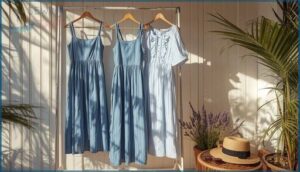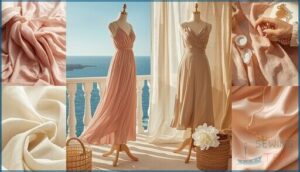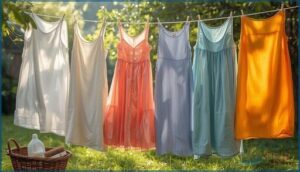This site is supported by our readers. We may earn a commission, at no cost to you, if you purchase through links.
A summer dress should feel like a soft breeze on your skin, not a weight you have to carry. Step outside in a heatwave, and you’ll discover that fabric isn’t just about fashion—it’s the difference between feeling light and free or stuck in a clingy, uncomfortable mess.
Cotton breathes, linen cools, and rayon flows, turning sweat and sun into an afterthought instead of a burden. Choosing fabric for summer dresses isn’t about picking a color—it’s about deciding how you want to move through sweltering days with confidence and ease, every detail working quietly for your comfort.
Table Of Contents
Key Takeaways
- Breathable fabrics like cotton, linen, and rayon keep you cool, dry, and comfortable when summer heat rises.
- The right fabric weight, weave, and moisture-wicking properties help your dress feel light and move easily with you.
- Durable, easy-care materials stand up to sun, regular washing, and daily wear without losing their shape or color.
- Sustainable choices—such as organic cotton, linen, Tencel, and blended fibers—offer comfort while being kind to the planet.
Key Factors When Choosing Summer Dress Fabrics
When picking fabric for your summer dress, there’s more to think about than just looks. Each choice can change how your dress feels, holds up, and works for the season.
Here are the key things to keep in mind.
Breathability and Comfort
Breathability is the silent promise of true summer comfort. You want a dress that lets air circulate and keeps you cool. Fabrics with high air permeability—like linen and lightweight cotton—score best for thermal insulation and microclimate comfort. Consumer preferences back this up. Considering the impact of fashion, bear in mind standards of beauty are culturally influenced. Breathable fabrics lead the way.
- Air Permeability
- Thermal Insulation
- Vapor Transmission
- Microclimate Comfort
- Consumer Preferences
Moisture Absorption and Management
You know the feeling—a dress that clings when you start to sweat. That’s where fabric hydrophilicity and moisture-wicking power step in.
Cotton and linen, with their high absorption and quick drying time, let moisture escape fast. Rayon and Tencel offer strong moisture management capability, keeping skin cool.
Choose breathable fabrics with a high wicking rate for superior thermal comfort. These reviews use repeatable research methods to synthesize evidence.
Sun Protection and UV Resistance
A summer dress lets you chase the sun, but don’t forget about sun protection. Breathable, lightweight fabrics offer freedom, yet their UPF rating can dip surprisingly low. Pay attention to:
- Weave density—tighter is better for blocking UV
- Color impact—darker shades absorb more rays
- Fabric finishes—some add extra UPF protection, but wet fabrics lose effectiveness fast
Make your shade intentional.
Durability and Ease of Care
After catching those rays, you want a dress that looks great wash after wash. Fabrics high in abrasion resistance and wash-wear resilience go the distance—think cotton blends and sturdy linens.
Prioritize ease of care: gentle washing keeps color fastness and reduces pilling potential. Wrinkle resistance, solid UV stability, and smart garment care all add up to a durable favorite.
Fabric Weight, Drape, and Texture
Elegance in motion—a dress that feels right always starts with fabric weight and comfort. Light weaves, like linen or organic cotton, let your skin breathe and move freely.
The drape and style depend on softness—think rayon or silk for flow, chambray for structure. Texture aesthetics—whether smooth or crisp—bring personality.
Embrace eco-friendly options, blending natural fabric combinations for unforgettable summer dress fabrics.
Best Fabrics for Hot Weather Dresses
When the weather heats up, your dress fabric choice can make all the difference. Some materials help you stay cool and comfortable, no matter how high the temperature climbs.
Here are the best fabrics to keep in mind for a summer dress that feels as good as it looks.
Cotton – Classic Breathable Choice
Think of cotton as your secret weapon for summer dresses. Cotton breathability and lightweight builds keep you feeling cool, even when the heat tries to cage you in.
Cotton durability means your dress lasts through sun and sweat, especially when you choose organic cotton or crisp, open weaves.
Cotton blends offer even more ways to personalize comfort—choosing the right fabric matters.
Linen – Ultimate Coolness and Comfort
Linen’s breathability gives you the feeling of pure freedom, refusing to trap heat or sweat. Thanks to its high moisture absorption and lightweight fabric weight, linen keeps your skin dry and comfortable even at noon.
Its loose weaving and natural UV protection set it apart, and with every wash, you’ll notice linen’s softness retention only grows.
Rayon and Modal – Lightweight and Flowing
When you crave a dress that moves with you, rayon and modal deliver. These lightweight, breathable fabrics offer fluid drape characteristics and cool comfort, especially on humid days.
Here’s why they’re clever summer picks:
- Excellent Moisture Management—no sticky skin.
- Lasting Fabric Durability, resisting daily wear.
- Sustainable Sourcing and easy Care Considerations for everyday life.
Chambray and Seersucker – Stylish Summer Options
Nothing says summer freedom like slipping into a chambray or seersucker dress. Chambray styling offers a balance between breathability and crisp structure, while Seersucker’s puckered texture provides lightweight coolness and quick thermal regulation. Both feature moderate to high UPF ratings—so you get style and sun protection. Keep care requirements in mind for summer dresses below.
| Feature | Chambray |
|---|---|
| Breathable Weaving | 3.2% higher airflow |
| UPF Ratings | 15–30 (denser = higher) |
| Feature | Seersucker |
| ——————— | ———————— |
| Texture | Puckered, light, airy |
| UPF Ratings | 25–40 (dark, tight) |
Jersey and Silk – Softness and Drape Benefits
Ready to make every move a statement? Jersey softness hugs your skin and keeps its cool, while silk drape adds luxury and enhances your silhouette—even in a heatwave. Silk’s moisture wicking keeps sweat at bay, and blended fabrics offer modern comfort.
Top reasons to love these summer dress fabrics:
- Adaptive comfort
- Simple sophistication
- Easy layering
- All-day freshness
Sustainable and Eco-Friendly Summer Fabrics
If you want your summer wardrobe to feel good for you and the planet, you have more choices than ever. Sustainable fabrics go beyond comfort—they’re about caring for how your dress is made.
Here’s what to look for in eco-friendly summer fabrics.
Organic Cotton and Linen
When you reach for organic cotton or linen in summer dresses, you’re choosing breathable comfort and sustainable fabrics crafted through ethical production. These natural fibers boast powerfully high weave density for reliable UV protection, and blended fabrics further boost breathability.
Careful fiber sourcing in both materials means your dress feels light but treads softly on the planet.
Choosing quality fibers gives you a dress that’s lightweight on you and gentle on the planet
Tencel and EcoVero Rayon
If you’re looking for sustainable fabrics with a silky drape, Tencel and EcoVero rayon are standouts. These fibers excel at moisture management, keep you feeling cool and dry, and their softness rivals linen. Tightly woven Tencel boosts UV protection, while EcoVero brings breathability to every breeze. Want a dress that’s kind to your skin—and the earth?
- Fresh comfort in the deepest heat
- Fabrics that hug, never cling
- Good-for-you, easy-care elegance
Hemp and Recycled Polyester Blends
If you crave adventure in both style and conscience, fiber blends like hemp with recycled polyester (rPET) strike the perfect balance. They wick moisture fast, offer UV protection, and bounce back with strong fabric recovery. Choosing these sustainable fabric options means less energy use, cool comfort, and a softer impact on the planet—summer dresses without compromise.
| Advantage | Benefit |
|---|---|
| Moisture Wicking | Fast evaporation |
| UV Protection | UPF 25–40 |
| Fabric Recovery | Fewer wrinkles |
| Lower Energy Use | 10–25% energy savings |
Environmental Impact and Certifications
You want sustainability to run as deep as your style. Eco-Certifications back up claims with real numbers—think OEKO-TEX or GOTS for textile certifications.
Water usage and fiber profiles matter, too. Natural fibers like linen cut resource use, while UV management boosts protection.
Understanding life cycle and ecofriendly options means you wear your environmental impact, not hide it.
Care Tips for Summer Dress Fabrics
Taking care of your summer dresses keeps them looking fresh and feeling great. Each fabric has its own way to shine with the right care. Here’s what you need to know before you start your routine.
Washing Recommendations by Fabric Type
When washing your summer dresses, consider each fabric’s mood. Cotton thrives in warm water and gentle cycles, while linen, rayon, and modal prefer it cool and delicate. Always choose a gentle detergent to protect fibers.
Have a tough stain? Act fast. Iron cotton or chambray on low—but skip high heat for jersey and silk.
Smart garment care keeps your favorites looking bold.
Air Drying and Shrinkage Prevention
While air-drying preserves both fabric shape and vibrant color, the subtle trick lies in controlling shrinkage. Hang lightweight cottons or linens to reduce tension, and always follow the care label for best results. Pre-shrinking methods and gentle cycles ward off surprises. For extra safeguard against distortion, lay garments flat or use a drying rack with even spacing.
- Air drying benefits: vibrant colors and fabric integrity
- Tension reduction: flat surface or drying rack minimizes distortion
- Pre-shrinking methods: lessen fabric shrinkage risk
Choosing Gentle Detergents
In your journey to lasting garment care, choosing gentle detergents matters more than you’d think. Skip harsh enzyme detergents—they can damage delicate fibers. Stain removal works best with cold water washing on a gentle cycle.
Steer clear of fabric softeners for lightweight dresses. Natural detergent alternatives, like soap nuts, pair well with mindful washing methods to protect texture and color.
Storing Summer Dresses Properly
Humidity control is your first line of defense when maintaining summer dresses—aim for 40–50% to block mold and odors. Fabric rotation each season keeps fibers lively and fresh. Store dresses in breathable garment bags, not airtight containers. Avoid sunlight exposure in your storage spot; even a little can fade colors.
General care tips? Wash, dry, then check for pests before tucking anything away.
Top 4 Summer Dresses and Their Fabric Choices
Finding the right summer dress starts with picking a fabric that matches your style and needs. Each of these four favorites stands out for how well they handle the heat and highlight your personality.
Here’s what you should know about their fabric choices.
1. Zattcas Women’s Smocked Swiss Dot Dress
Searching for a summer dress that blends playful elegance with breathable comfort? The Zattcas Women’s Smocked Swiss Dot Dress stands out, thanks to its lightweight polyester fabric with Swiss dot details that mimic the airy feel of fine cotton.
The smocked bust flatters your silhouette, while the flutter sleeve design adds a touch of romance.
Loved for its occasion versatility, this dress works whether you’re headed to brunch, the beach, or a dinner out. It’s a true tribute to what summer dresses should feel like.
Best For: Those who want an airy, feminine summer dress that works for everything from casual lunches to weddings or vacation getaways.
- Breathable Swiss dot fabric feels light and comfortable in hot weather.
- Smocked bust and ruffle details create a flattering, flowy silhouette.
- Versatile enough for everyday, parties, or even as a maternity dress.
- Arm openings can feel tight, especially for those with larger upper arms.
- Material is on the thinner side and may not be as durable as heavier fabrics.
- May not flatter all body types, particularly during pregnancy.
2. Women’s Summer Lantern Sleeve Mini Dress
Ever notice how a lantern sleeve mini dress can spark instant confidence? This style pairs bold, airy sleeves with an A-line shape—a combination that flatters nearly every body type.
Mini Dress Versatility shines here; wear it anywhere, from office to evening. The fabric blend—70% polyester, 25% rayon, 5% spandex—delivers breathable stretch and all-day comfort. It’s lightweight and soft, perfect for hot days.
Side pockets and a tie-front waist offer just the right mix of practicality and playful summer clothing ease.
Best For: Anyone looking for a comfortable, easy-to-style summer dress that’s flattering for many body shapes and works for both casual and dressy events.
- Airy lantern sleeves and A-line shape create a flattering, confidence-boosting silhouette.
- Soft, stretchy fabric blend stays comfy even on hot days.
- Side pockets and adjustable tie waist add style and practicality.
- Color may look different depending on your screen.
- Lighter shades can be a little see-through.
- Runs a bit large, so you might want to order a size down.
3. Women’s Linen Maxi Dress Summer Casual
When you need both freedom and simple elegance, a linen maxi dress is a smart go-to. This style rides high on linen’s breathable, lightweight fabric, letting air flow easily. Back tie details, pockets, and those relaxed, adjustable straps keep you comfortable from brunch to beach.
You’ll get the most from this maxi at vacations, summer parties, or just unwinding at home. Watch the chest fit—size up if you’re fuller in the bust. Linen dress benefits shine, but wrinkles and hand wash care remain.
Best For: Those who want easy-breezy comfort and simple style for summer getaways, parties, or relaxed days at home.
- Breathable linen/cotton blend keeps you cool in warm weather.
- Relaxed fit with adjustable straps and handy side pockets.
- Versatile design can be dressed up or down for any occasion.
- Linen tends to wrinkle easily and needs hand washing.
- Some users report a snug fit in the chest area, especially for larger busts.
- Occasional complaints of color variations and strap durability.
4. Womens V Neck Summer Dress
Swap linen for stretch, and the V-neck summer dress opens up new styling options for every body type.
Here, soft fabric blends—mostly polyester and spandex—embrace your shape with a loose fit, letting the dress skim instead of squeeze. Sleeveless and knee-length, it keeps things breathable and lightweight, perfect for hot days and almost any occasion.
The gently curved hemline flatters, while the V-neck benefits your neckline, making accessorizing easy, whether you’re slipping away to brunch or headed into the evening.
Best For: Anyone looking for an easy-going, flattering dress that feels cool and comfortable on warm days, especially if you prefer a fit that moves with you.
- Soft, stretchy fabric feels great and suits many body shapes.
- Versatile design works for casual outings, work, or vacation.
- Easy to style and care for—machine washable and low-fuss.
- May run smaller than expected, so sizing up is advised.
- Some users report minor pilling or sheerness, needing a slip underneath.
- The dress doesn’t have pockets, which might disappoint some.
Frequently Asked Questions (FAQs)
What is the best fabric to use for a summer dress?
Think of summer dresses as your ticket to easy living—choose fabrics that let your skin breathe.
Cotton and linen rise to the top for their breathability, moisture wicking, and relaxed drape, blending comfort with simple style.
What is the best fabric for summer shift dresses?
For summer shift dresses, lightweight cotton or linen wins, hands down. Both shine in breathability tests thanks to airy weaving, cool against skin, and create crisp drape quality.
Each offers affordable cost comparison and adaptable silhouette options for summer dresses.
What is the best fabric for hot summers?
Choosing the right fabric in hot summers is like finding shade on a sunburned street—look for light cotton or linen.
They win out for fabric breathability, moisture wicking, and comfort factors, helping your summer dresses feel breezy.
What kind of fabric is suitable to dress up and play in summer why?
Lightweight, breathable fabrics like cotton, linen, or rayon keep you cool during high activity levels. Their comfort and versatility make them perfect for summer dresses, whether you’re dressing up for an occasion or playing outside.
Fabric weight and color impact style.
How do I know if a fabric is breathable?
To tell if a fabric is breathable, check for air circulation—try holding it to your mouth and blowing through.
Look for clues from Air Permeability Tests, high Moisture Vapor Rate, or open weave and porosity.
What fabrics are best for hot, humid weather?
Think of fabric as your personal shade tree—when heat and humidity rise, reach for linen and cotton.
Both shine for their fiber breathability, moisture wicking, UV protection, and comfort factors, leaving you cool, dry, and light.
Are there any fabrics that are both lightweight and durable?
You want a summer fabric that’s got muscle and finesse—go for cotton twill blends, ripstop cotton, or linen-cotton blends.
These lightweight fabrics boast impressive tear strength, abrasion resistance, pilling reduction, and blend benefits. They’re tough, airy champions.
How do I choose a fabric thats comfortable and stylish?
Picture slipping into a dress that feels light as air yet speaks to your soul.
Prioritize fabric aesthetics, breathability, and comfort, then align choices with personal style, occasion suitability, body type, and budget considerations for simple summer dresses.
How do fabric patterns affect summer dress style?
Pattern breathability and pattern weight transform summer dresses—micro-prints and airy weaves keep you cool, while vertical stripes accentuate silhouette influence.
Color interaction shapes mood; playful patterns and classic botanicals define summer fashion style and inspire fresh design trends.
What are the best fabrics for sensitive skin?
Ever felt that sharp itch or redness on a hot day? Fabrics truly matter. Breathable cotton and linen, with smooth fibers and tight weave density, reduce irritation. Dye sensitivity drops with natural finishes, making skin irritation far less likely.
Conclusion
Think of choosing fabric for summer dresses as planting seeds for the season you want. Cotton, linen, rayon, and their sustainable cousins shape each day into something lighter, softer, and unmistakably yours.
Each choice is a whispered promise of comfort—subtle armor against heat. When the sun feels relentless and the air grows thick, remember: your dress isn’t just what you wear, but how you claim freedom, one cool, confident step at a time.















